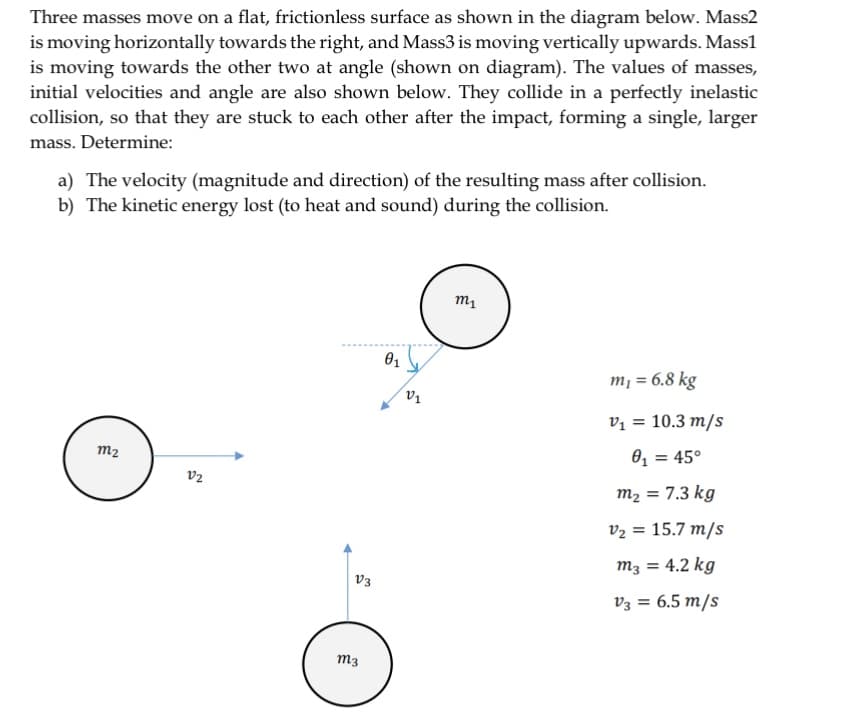Three masses move on a flat, frictionless surface as shown in the diagram below. Mass2 is moving horizontally towards the right, and Mass3 is moving vertically upwards. Mass1 is moving towards the other two at angle (shown on diagram). The values of masses, initial velocities and angle are also shown below. They collide in a perfectly inelastic collision, so that they are stuck to each other after the impact, forming a single, larger mass. Determine: a) The velocity (magnitude and direction) of the resulting mass after collision. b) The kinetic energy lost (to heat and sound) during the collision. m1 m¡ = 6.8 kg Vị = 10.3 m/s m2 8, = 45° v2 m2 = 7.3 kg V2 = 15.7 m/s m3 = 4.2 kg %3D v3 V3 = 6.5 m/s m3
Three masses move on a flat, frictionless surface as shown in the diagram below. Mass2 is moving horizontally towards the right, and Mass3 is moving vertically upwards. Mass1 is moving towards the other two at angle (shown on diagram). The values of masses, initial velocities and angle are also shown below. They collide in a perfectly inelastic collision, so that they are stuck to each other after the impact, forming a single, larger mass. Determine: a) The velocity (magnitude and direction) of the resulting mass after collision. b) The kinetic energy lost (to heat and sound) during the collision. m1 m¡ = 6.8 kg Vị = 10.3 m/s m2 8, = 45° v2 m2 = 7.3 kg V2 = 15.7 m/s m3 = 4.2 kg %3D v3 V3 = 6.5 m/s m3
Glencoe Physics: Principles and Problems, Student Edition
1st Edition
ISBN:9780078807213
Author:Paul W. Zitzewitz
Publisher:Paul W. Zitzewitz
Chapter4: Forces In One Dimension
Section: Chapter Questions
Problem 66A
Related questions
Topic Video
Question
I'm confused on how to solve when adding a third element .

Transcribed Image Text:Three masses move on a flat, frictionless surface as shown in the diagram below. Mass2
is moving horizontally towards the right, and Mass3 is moving vertically upwards. Mass1
is moving towards the other two at angle (shown on diagram). The values of masses,
initial velocities and angle are also shown below. They collide in a perfectly inelastic
collision, so that they are stuck to each other after the impact, forming a single, larger
mass. Determine:
a) The velocity (magnitude and direction) of the resulting mass after collision.
b) The kinetic energy lost (to heat and sound) during the collision.
m1
m¡ = 6.8 kg
Vị = 10.3 m/s
%3D
m2
0, = 45°
%3D
vz
m2 = 7.3 kg
v2 = 15.7 m/s
m3 = 4.2 kg
V3
V3 = 6.5 m/s
m3
Expert Solution
This question has been solved!
Explore an expertly crafted, step-by-step solution for a thorough understanding of key concepts.
This is a popular solution!
Trending now
This is a popular solution!
Step by step
Solved in 3 steps with 1 images

Knowledge Booster
Learn more about
Need a deep-dive on the concept behind this application? Look no further. Learn more about this topic, physics and related others by exploring similar questions and additional content below.Recommended textbooks for you

Glencoe Physics: Principles and Problems, Student…
Physics
ISBN:
9780078807213
Author:
Paul W. Zitzewitz
Publisher:
Glencoe/McGraw-Hill

Glencoe Physics: Principles and Problems, Student…
Physics
ISBN:
9780078807213
Author:
Paul W. Zitzewitz
Publisher:
Glencoe/McGraw-Hill